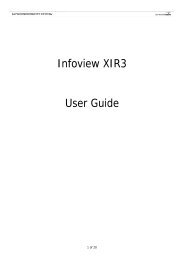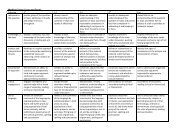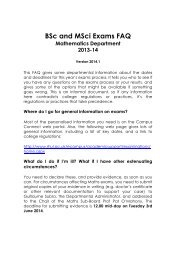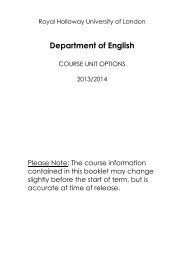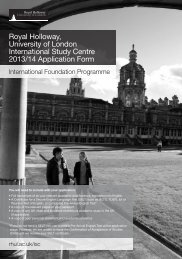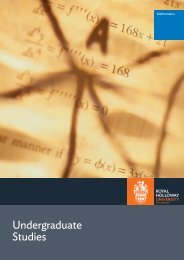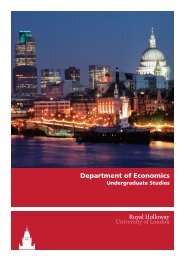Financial Statements 2011 - Royal Holloway, University of London
Financial Statements 2011 - Royal Holloway, University of London
Financial Statements 2011 - Royal Holloway, University of London
Create successful ePaper yourself
Turn your PDF publications into a flip-book with our unique Google optimized e-Paper software.
Notes to the <strong>Financial</strong> <strong>Statements</strong>(continued)Use <strong>of</strong> these mortality tables reasonably reflects the actual USSexperience but also provides an element <strong>of</strong> conservatism to allowfor further improvements in mortality rates. The assumed lifeexpectations on retirement at age 65 are:Males (females)currently aged 65Males (females)currently aged 4522.8 (24.8) years24.0 (25.9) yearsAt the valuation date, the value <strong>of</strong> the assets <strong>of</strong> the scheme was£28,843 million, and the value <strong>of</strong> the scheme’s technical provisions was£28,135 million indicating a surplus <strong>of</strong> £708 million. The assets thereforewere sufficient to cover 103% <strong>of</strong> the benefits which had accrued tomembers after allowing for expected future increases in earnings.The actuary also valued the scheme on a number <strong>of</strong> other bases asat the valuation date. On the scheme’s historic gilts basis, using avaluation rate <strong>of</strong> interest in respect <strong>of</strong> past service liabilities <strong>of</strong> 4.4%per annum (the expected return on gilts) the funding level wasapproximately 71%. Under the Pension Protection Fund regulationsintroduced by the Pensions Act 2004 the scheme was 107% funded;on a buy-out basis (i.e. assuming the scheme had discontinued onthe valuation date) the assets would have been approximately 79%<strong>of</strong> the amount necessary to secure all the USS benefits with aninsurance company; and using the FRS 17 formula as if USS was asingle employer scheme, using a AA bond discount rate <strong>of</strong> 6.5% perannum based on spot yields, the actuary estimated that the fundinglevel at 31 March 2008 was 104%.The technical provisions relate essentially to the past serviceliabilities and funding levels, but it is also necessary to assess theongoing cost <strong>of</strong> newly accruing benefits. The cost <strong>of</strong> future accrualwas calculated using the same assumptions as those used to calculatethe technical provisions except that the valuation rate <strong>of</strong> interestassumed asset outperformance over gilts <strong>of</strong> 1.7% per annum(compared to 2% per annum for the technical provisions) giving adiscount rate <strong>of</strong> 6.1% per annum; also the allowance for promotionalsalary increases was not as high. There is currently uncertainty in thesector regarding pay growth. Analysis has shown very variable levels<strong>of</strong> growth over and above general pay increases in recent years, andthe salary growth assumption built into the cost <strong>of</strong> future accrual isbased on more stable, historic, salary experience. However, whencalculating the past service liabilities <strong>of</strong> the Scheme, a cautionaryreserve has been included, in addition, on account <strong>of</strong> the variabilitymentioned above.The scheme-wide contribution rate required for future servicebenefits alone at the date <strong>of</strong> the valuation was 16% <strong>of</strong> pensionablesalaries and the trustee company, on the advice <strong>of</strong> the actuary,agreed to increase the institution contribution rate to 16% <strong>of</strong>pensionable salaries from 1 October 2009.Since 31 March 2008 global investment markets have continued t<strong>of</strong>luctuate and at 31 March 2010 the actuary has estimated that thefunding level under the new scheme specific funding regime hadfallen from 103% to 91% (a deficit <strong>of</strong> £3,013m). Compared to theprevious 12 months, the funding level has improved from 74% (asat March 2009) to 91%. This estimate is based on the funding levelat 31 March 2008, adjusted to reflect the fund’s actual investmentperformance over the two years and changes in market conditions(market conditions affect both the valuation rate <strong>of</strong> interest andalso the inflation assumption, which in turn impacts on the salaryand pension increase assumptions).On the FRS 17 basis, using a AA bond discount rate <strong>of</strong> 5.6%per annum based on spot yields, the actuary estimated thatthe funding level at 31 March 2010 was 80%. An estimate <strong>of</strong>the funding level measured on a buy-out basis at that date wasapproximately 57%.Surpluses or deficits which arise at future valuations may impacton the College’s future contribution commitment. A deficit mayrequire additional funding in the form <strong>of</strong> higher contributionrequirements, where a surplus could, perhaps, be used to similarlyreduce contribution requirements. The sensitivities regardingthe principal assumptions used to measure the scheme liabilitieson a technical provisions basis as at the date <strong>of</strong> the last triennialvaluation are set out below:Assumption Change in assumption Impact on scheme liabilitiesValuation rate <strong>of</strong> interest Increase / decrease by 0.5% Decrease / Increase by £2.2bnRate <strong>of</strong> pension increases Increase / decrease by 0.5% Increase / decrease by £1.5bnRate <strong>of</strong> salary growth Increase / decrease by 0.5% Increase / decrease by £0.7bnRate <strong>of</strong> mortality More prudent assumption Increase by £1.6bn(move to long cohort)37



